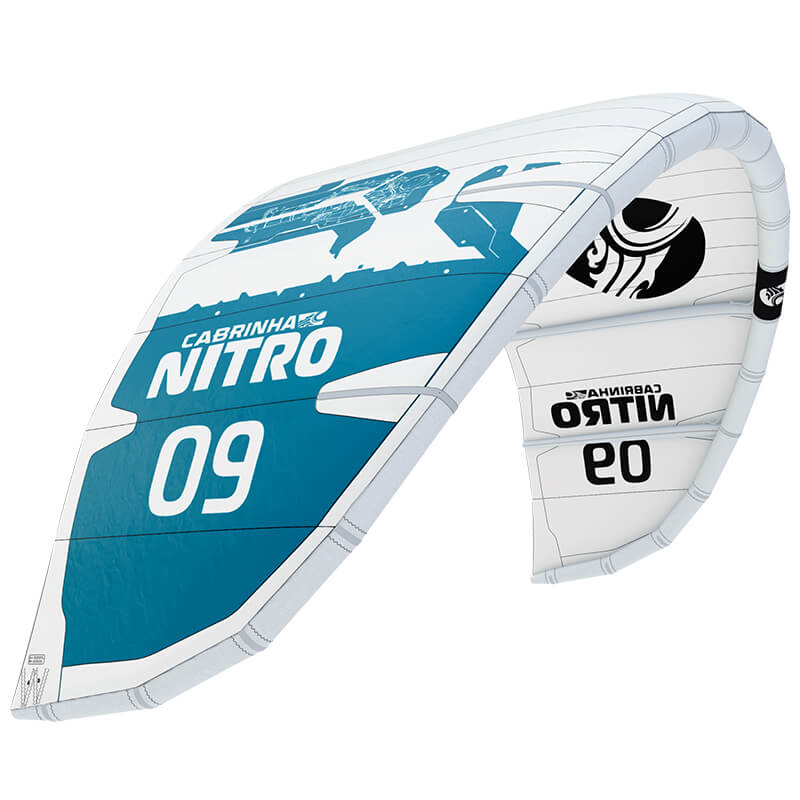When you purchase gear through links on our site, we may earn a small commission. Here’s why you can trust our tests and our affiliate partner.

In life, it’s often said that timing is everything. Cabrinha have had an all-new kite in the pipes to cater for the latest Big Air upsurge and all the new technicalities of double loops and S loops. We’re stoked that they decided to phoenix the Nitro model name, which we have fond and formative early noughties memories of, and kite design legend Pat Goodman had freedom to design it from the ground up, giving it a contemporary twist. This has timed perfectly with various high profile Big Air competitions to showcase what the Nitro is capable of, and – judging by the footage we have seen – it certainly hasn’t disappointed.
Technically we’re presented with a mid to high-aspect five-strut kite with swept wingtips and plenty of canopy presented to the wind – it’s got all the design cues of a Big Air model. An all new airframe material has been implemented in the Nitro which Cabrinha have assigned their range-topping Apex designation. It’s a stiffer, lighter tube called Ultra HT which allows for some leaner leading edge and strut diameters. The struts in particular show some work and have been foiled back and refined beautifully.
On initial impressions, handling is perhaps the key point with the Nitro. It’s light, precise and fast, perhaps the antithesis of the classic Switchblade, and definitely the quickest and snappiest Cabrinha kite we’ve ever ridden. What’s most impressive and important is how balanced and direct the feedback is; there’s constant information through the bar allowing you to correct steering inputs rapidly if you manage to over send the kite. The Nitro sits quite far forward and generally likes to dwell towards the edge of the wind window; this is as expected for something with relatively trim tube diameters. What’s key is that it doesn’t at any point overfly, and this eagerness to surge forward translates into one of the most reassuring catch characteristics out of a kiteloop we’ve experienced. It also has the secondary benefit of absolutely trucking upwind with little effort.
Again, the handling makes redirecting for a jump produce some vertical lift which is amongst the best in class. It’s as if the bottom half of the bar stroke is a power band for boosting and thrust, and the top half is for correction and control and this blends together progressively. The kiteloop is a very direct and smooth pulse of power, and extremely regular and predictable. There’s no hesitation in the kite, allowing you to choose how level you are with the kite, and the climb and catch is as regular as clockwork without any fear of the knee surgeon. In essence the Nitro has as much performance as you could want from a next-generation Big Air kite in terms of boosting and looping, as well a decent level of accessibility for the average Joe or Joanna.
It’s been well documented that the double loop is certainly achievable on the Nitro in the smaller sizes and the cutting edge performance level in terms of height achievable combined with the turning speed is very effective at competition level, as Stino regularly demonstrates.
Its extreme performance potential aside, for the average punter, what’s most important in a Big Air kite is how much confidence the kite instils when you’re dangling upside down 20m above the water, when you want upmost confidence in your handling and kite position awareness. The Nitro has this in spades, which we think is down to a combination of Pat Goodman’s magic touch and massive kite design legacy, as well as intelligent modern material choices keeping things ultra crisp. A solid performance in an extreme situation is the hallmark of a well-designed modern Big Air machine. Industry-wide, we’re getting quite spoiled for choice in this sector, and as far as we’re concerned the Nitro is definitely a stand out.
